Sucrose esters, specialty emulsifiers
- Like
- Digg
- Del
- Tumblr
- VKontakte
- Buffer
- Love This
- Odnoklassniki
- Meneame
- Blogger
- Amazon
- Yahoo Mail
- Gmail
- AOL
- Newsvine
- HackerNews
- Evernote
- MySpace
- Mail.ru
- Viadeo
- Line
- Comments
- Yummly
- SMS
- Viber
- Telegram
- Subscribe
- Skype
- Facebook Messenger
- Kakao
- LiveJournal
- Yammer
- Edgar
- Fintel
- Mix
- Instapaper
- Copy Link
Posted: 30 October 2015 | Lia Bax, Product & Sales manager Sisterna BV The Netherlands | 10 comments
Lia Bax discusses the emulsion power of sucrose esters and gives an overview of the numerous and sometimes unexpected products they can be used in…
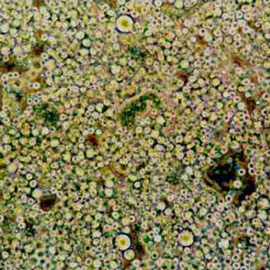

Sucrose esters of fatty acids, commonly known as sucrose esters (E473), are a special type of emulsifiers.
Sucrose esters have several benefits besides emulsification, such as starch interaction, protein protection, sugar crystallisation and aeration. In this article the emulsification functionality will be highlighted.
The most interesting aspects of sucrose esters are their water solubility and high Hydrophilic-Lipophilic Balance (HLB) value.
Water solubility
In all of the typical emulsions, there are small droplets (dispersed phase) suspended in a liquid (continuous phase). In an oil-in-water emulsion, oil is the dispersed phase, while water is the continuous phase. When oil and water are mixed, what type of emulsion will be formed; O/W or W/O? The Bancroft rule (named after Wilder Dwight Bancroft, an American physical chemist) states: “The phase in which an emulsifier is more soluble will be the continuous phase”. So even though there may be a formula that’s 60% oil and 40% water, if the emulsifier chosen is more soluble in water, it will create an oil-in-water system.
Sucrose esters are water soluble, so they will create an oil-in-water emulsion.
HLB Value
Emulsifiers are characterised by their HLB value. The Hydrophilic – Lipophilic Balance of a surfactant is a measure of the degree to which it is hydrophilic (water loving) or lipophilic (oil loving), determined by calculating or measuring values for the different regions of the molecule. An emulsifier with a high HLB value is water soluble, an emulsifier with a low HLB value is oil soluble. Emulsifiers with different HLB-values have different functionalities:
Low HLB 3-6 good W/O-emulsifier
Medium HLB 7-9 good wetting agent
High HLB 10-18 good O/W-emulsifier
In the food industry a number of emulsifiers are commonly used. This chart gives an overview of the commercial emulsifiers, their e-number and their HLB range:
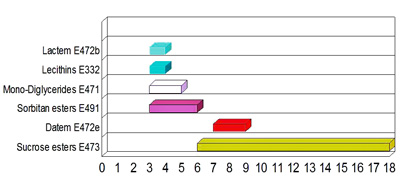

A low HLB, oil soluble emulsifier, can be ‘forced’ to create an oil-in-water emulsion. Multiple examples of this can be found in the supermarket. This can be done by adding oil to water while shearing. However, this will never result in the best emulsion stability. Stability of an emulsion strongly depends on the oil droplet size; smaller oil droplets result in better stability.
Sucrose esters, such as those produced by Sisterna, offer excellent emulsifying properties so result in emulsions with very small oil droplets. Below are microscopic pictures (400 * magnitude) of dressing (20% oil).
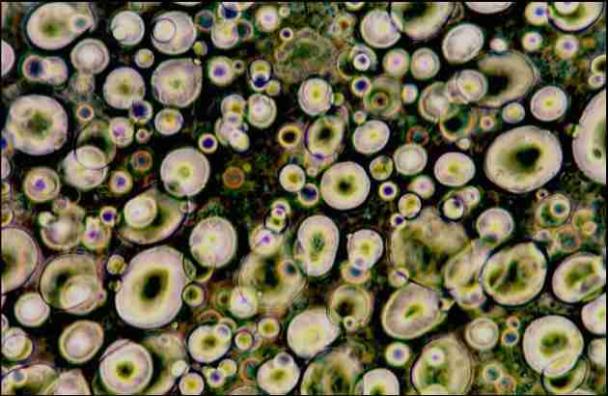

Dressing with 1% Mono-di glycerides
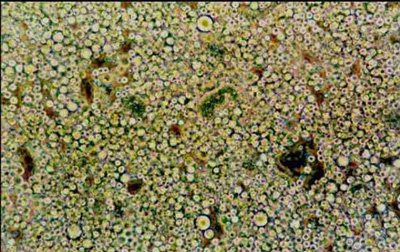

Dressing with 0.5% Sisterna SP70
Emulsions with sucrose esters have:
- Smaller fat globules / oil droplets
- Improved stability
- Improved creamy mouth feel (a large number of small oil droplets give the impression of a higher fat content)
- Improved flavour perception
- Whiter colour (light is scattered differently on smaller oil droplets)
- Fat/oil is better protected against e.g. oxygen and light (inhibition oxidation/rancidity in e.g. fudge
- Fat/oil is better divided through the product (anti-stickiness in e.g. high sugar products)
The emulsion power of sucrose esters can be used in numerous and sometimes unexpected products. Following is a short overview of some possibilities.
Mayonnaise and dressing
For emulsification traditionally egg yolk is used, however this is being more and more replaced by emulsifying components such as proteins or emulsifiers. Sucrose esters can be such an alternative to egg yolk. The high HLB types are cold water soluble and thus suitable for cold emulsification as well as a hot emulsification process. What makes sucrose esters exceptional is their high HLB value which helps in creating very small oil droplets. This results in a very white stable sauce with a creamy mouth feel and a mild taste. This functionality is particularly valuable for making a low fat sauce without decreasing the creaminess. Although sucrose esters are sensitive to low pH (below 4), the acidity of mayonnaise does not have to be a problem. When the pH is slightly lower than 4, the best way to work is to prepare the emulsion, before adding the acid components. In that way the sucrose esters are partly dissolved in the oil droplet, where they are less sensitive to acid.
(White) sauces
In most sauces proteins, such as milk powder or whey powder, are used for emulsification and stabilisation. Sucrose esters can replace dairy proteins, and improve the emulsion stability. Proteins act as oil-in-water emulsifiers, but sucrose esters are much more powerful emulsifiers.
It is even possible to decrease the starch or stabiliser content. With sucrose esters the emulsion has sufficient stability and does not have to rely on a high viscosity. With less stabilisers the sauce will become less heavy and gluey, but will be satiny and have an excellent flavour release.
During pasteurisation or sterilisation, a Maillard reaction can take place between proteins and sugars, resulting in the formation of a brown-greyish colour. This is a significant problem in cooking cream sauces that should have a light colour, like béchamel sauce. When proteins are replaced by sucrose esters, no Maillard reaction can take place. White sauce with sucrose esters is white, smooth, stable and tasty.
In order to keep the typical taste and texture of dairy proteins in sauce, a partial replacement by sucrose esters is a good option.
Special emulsions
Fat soluble ingredients such as omega-3 and some natural colours are mainly available as powders, fat flakes or oils. For beverages, dairy and confectionery, there is a growing interest for ingredients in liquid, water dispersible shape. A concentrated oil emulsion (in glycerol or water) could be a solution.
Sisterna have developed a technology to make concentrated oil emulsions. Manufacturers of e.g. omega-3, sterols or natural colours can use this technology, based on oil-in-glycerol, with sucrose esters as emulsifier. The emulsions are fluid to paste like and have long term stability. The emulsion can be used in solid foods such as confection, as well as in low viscous, mild acidic applications such as fruit drinks. When the soft drinks requires improved acid stability, sucrose esters can be combined with lecithin or Datem.
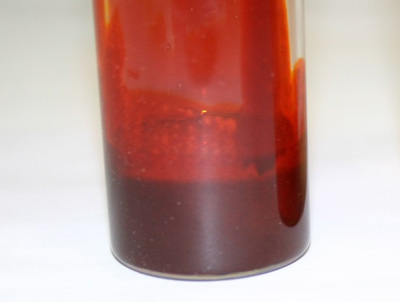

Picture of Paprika oleoresin / glycerol emulsion with Sisterna sucrose esters
The concentrated emulsion technology with sucrose esters makes it possible to create an emulsion with very small oil droplets (around 1 μm), with simple equipment like a high shear mixer. This concentrated emulsion can be diluted with (e.g.) water, and in that way a low viscous stable emulsion can be formed.
Milk alternatives
More and more people are looking for alternatives for dairy products; nowadays, especially in drinks, there are many options available, based on soya, almonds, rice, coconut etc. Sucrose esters have two functionalities in these products.
Sucrose esters will emulsify the oil in the product. Especially in low viscous products like drinks, it is important to get very small oil droplets. In drinks the emulsion stability is not helped by viscosity, and strongly depends on the size of the oil droplets and the power of the emulsifier. Sucrose esters, and a high pressure homogeniser will work together to reach ultra small oil droplets , preventing an oil ring (in case of a bottle) and making the “milk” whiter.
Milk alternatives all contain proteins. And just like caseinate, these proteins also have an iso-electric point. Some are even more sensitive to acid than milk. Sucrose esters will interact with these proteins, stabilising the milk-alternative against flocculation.
Aerated dairy
Aerated dairy desserts like ice cream, mousse and whipped topping, require opposite functionalities from an emulsifier. In the liquid mix, an emulsifier with a high HLB value (like sucrose esters) is best. Sucrose esters will quickly replace the proteins from the fat globule (aging can be shorter). The mix is stable; no fat separation and no churning will take place.
When the product is aerated, the emulsion should be destabilised slightly, in order to form a fat-network around the air cells. Emulsifiers with a low HLB value are more suitable for this.
The best results are reached by combining high HLB sucrose esters with low HLB emulsifiers like MDG or α-tending emulsifiers (e.g. lactic acid esters).
Sucrose esters strongly decrease the surface tension between water and air, so aeration will quickly lead to a high overrun.
Besides technical benefits, sucrose esters will give aerated dairy desserts a fresh, and less greasy mouthfeel as there is less free fat to form a fatty greasy film in your mouth. Flavours will be much more pronounced, which is especially important in products with delicate natural flavours or chocolate flavour.
Low fat fillings
The most commonly used fillings consist of creamed fat (40%) in which components such as sugar, milk powder, cocoa powder are dispersed to create the right flavour.
A good way to reduce the fat in fillings, is to make a water continuous filling. Only a small portion of fat or oil (6-15%) is emulsified in the water phase. This type of filling can have a mousse like texture with a much lower density than a creamed filling.
Sucrose esters will emulsify the fat or oil in the water phase, and facilitate aeration.
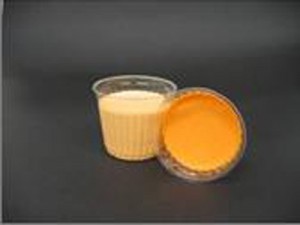

Picture of aerated low fat filling; Left based on medium HLB sucrose esters, right based on high HLB sucrose esters.
To ensure microbial stability, the water phase should contain bulking ingredients like soluble fibre and other ingredients that decrease the water activity. As there will be quite some water in such fillings, they can only be used in ‘moist’ products like cake (similar water activity).
Cereal bars and other sticky high-sugar products
Stickiness can be a difficulty in the production of high-sugar products. The product sticks to transportation belts or cutting equipment causing loss of product and more frequent production stops for cleaning.
Sucrose ester eases the mixing of fat into the sugary product, e.g. in the binding syrup of cereal bars. The small oil droplets that are created, with the help of sucrose esters, act as a release agent. Sucrose esters optimise the lubrication capacity of fats and oil, which results in a significant reduction of stickiness.
Chewy soft candy and fudge
Chewy soft candies, like toffee, fudge or chews are examples in which sucrose esters can improve softness. Sucrose ester molecules speed up crystallisation and form a layer around sugar crystals. This layer inhibits further crystal growth, enhancing a soft texture.
Additionally the fat content can be raised; sucrose esters disperse the fat in very small oil droplets giving a good mouth feel without the risk of oiling.
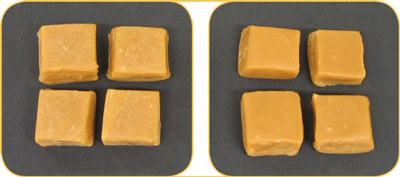

Picture of fudge; left with lecithin, right with Sisterna SP50
This tight packing of the oil droplets in the sugar matrix will make the fat less attainable for oxygen and light, the initiators for oxidation. This will result in a delay in oxidation of the fat and improves the ‘anti-rancidity’ of the soft candy.
Aerated fruit
A foam is also a type of emulsion, a mix of water(phase) and air, normally not miscible. Emulsifiers that emulsify oil in water, will also be good aerating agents. Sucrose esters strongly decrease the surface tension between water and air, so air is easily incorporated in a watery product. Sucrose esters, especially the medium HLB types, will also stabilise the foam. However, to ensure a long shelf life without syneresis and shrinkage, a blend of selected stabilisers and gelling agents has to be chosen.
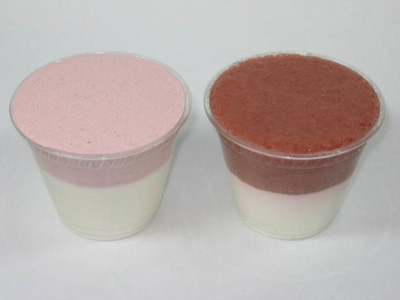

Picture of aerated fruit prep with sucrose esters on top of yoghurt. Left density 0.6 g/cm3, right 0.8 g/cm3
Sisterna sucrose ester can be used in numerous other food products, and for several other reasons too. In the described applications, the main functionality of sucrose esters is emulsification. However, sucrose esters have more capabilities. The most important functionalities next to emulsification are protein protection, starch interaction and sugar crystallisation. These extra options make sucrose esters valuable ingredients for dairy products, bakery products and confectionery.
Finally some general benefits of sucrose esters:
- High grade emulsifiers
- Wide HLB range
- Neutral in taste, odour and colour
- Soluble in (cold) water
- Stable under UHT conditions
- Natural and renewable raw materials
- Kosher, Halal, non-GMO, vegetarian, trans fat free
About Sisterna
Sisterna, European market leader in sucrose esters, is proud to demonstrate the multifaceted effect of sucrose esters in emulsions. Sisterna distinguishes itself as a flexible partner that will help find technical solutions in the development, improvement and process optimising of food products. From the Netherlands Sisterna presents the most up-to-date service in sales support and knowledge development. Contact Sisterna for all the benefits that can be achieved with sucrose esters.
For more information about Sisterna BV or sucrose esters please take a look at www.sisterna.com.
About the author


Lia Bax
Lia is educated in food engineering and has over 25 years’ experience as food technologist in emulsifiers, stabilisers and fibres, and their application in the food industry, mainly bakery, dairy, confectionery and sauces & special emulsions. She started in a laboratory to research the application possibilities of all kinds of food ingredient, and is now working in a more commercial role, focussed on sucrose esters.




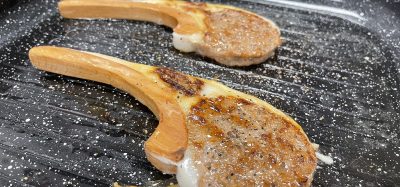



im looking for emulsifier that can help to make cold soluble fat powder 35 %
In which solution do sucrose esters dissolve better to add them to a food product? In distilled water or mineral water? and, is it better to do it at high or ambient temperature?
Thank you very much!
i would like to know if there any surfactant with the same characteristics of sucrose ester
I understand that this sucrose ester is kosher certified. Which organization is giving the kosher certification? How is it possible to receive a copy of the kosher certificate?
Contact http://www.sisterna.com and they should be able to answer your question
Hello,
I just wonder that is this additive ilegal in Europe?
Thank you.
Dear Donghyun, Yes, sucrose esters are permitted in a large number of food stuffs in Europe and also the rest of the world. Are you interested in a specific application? Regards, Lia Bax
do you have any suggestion for adding weighting agent in oil system that can avoid separation? sucrose ester is water soluble. I am looking for more oil soluble that can be used in surimi and meat. thanks
Dear Sophie, there are several types of sucrose esters. Also fat-soluble grades. We have no experience with sucrose esters as weighing agents for oils. In case you want to try sucrose esters, contact us through our website. Regards, Lia Bax
I would like to know if there is any surfactant with the same characteristics/properties of sucrose ester but palm free origin.
Thank you very much. Great article!